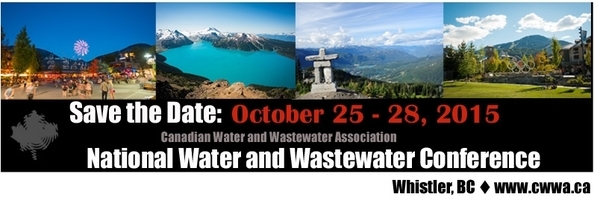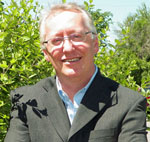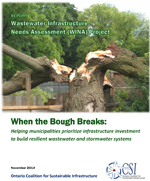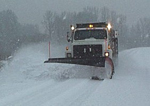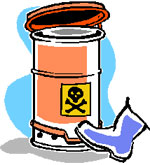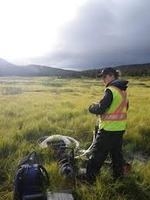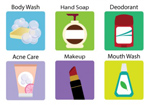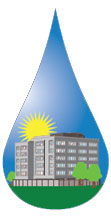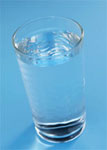| January 22, 2015
|
In This Issue |
|
CWWA News
|
|
|
Member News
|
|
|
Federal Initiatives
|
|
|
National News
|
|
|
Provincial News
|
|
|
Snippings and Clippings
|
|
Be sure to mark your calendar for CWWA’s first National Water and Wastewater Conference. The Conference is scheduled for October 25-28 at the Fairmont Chateau Whistler – an amazing venue that will bring our delegates together in one of the most beautiful parts of the country.
If you didn’t attend our last Window on Ottawa, you might have heard us laughing from where you were. After a wonderful day of learning, our delegates were thoroughly entertained by Canada’s funniest stand-up comedian, Ron James – celebrating World Toilet Day of course.
|
No it’s not moving cities, or else we couldn’t call it the Window on ‘Ottawa’. But it is moving from its traditional dates. The Window on Ottawa is truly our signature event that meets two of our core goals – to educate our members on national level activity and to facilitate dialogue with the federal government and its agencies. This very informative event allows delegates to hear the latest news from key members of federal departments and agencies. We get the details of recent legislation, but more importantly, we hear about what is in the development stages and can provide comments.
|
The Ontario Coalition for Sustainable Infrastructure (OCSI) recently launched a new report based on it’s research and consultation on the Wastewater Infrastructure Needs Assessment (WINA) project.
|
Recognizing that road salt can threaten freshwater ecosystems, soil, vegetation and wildlife, Environment Canada has released a set of performance indicators and national targets to better protect the environment. On average, more than 5 million metric tons of road salts are used in Canada each year. A 2001 environmental assessment concluded that road salts were entering the environment in significant quantities through losses at salt storage and snow disposal sites, as well as through runoff and splash from roadways. The new "code of practice" is voluntary but mandatory measures are not ruled out in the future.
|
CCME has published A Protocol for the Derivation of Groundwater Quality Guidelines for Use at Contaminated Sites. This protocol establishes a framework for developing Canadian Groundwater Quality Guidelines that ensures an appropriate level of protection for both human and environmental receptors. It is a companion to A Protocol for the Derivation of Environmental and Human Health Soil Quality Guidelines (CCME, 2006) which should be consulted for additional background and underlying principles.
|
Bloom Lake General Partner Limited was ordered to pay $7.5 million in the Criminal and Penal Division of the Court of Quebec in Montreal, December 19, 2014, after pleading guilty to 45 charges under the Fisheries Act, resulting from several incidents including the breach of a tailings pond dam
|
In response to the catastrophic decline in Canadian bat populations, an Emergency Listing Order under the Species at Risk Act was published in the December 17, 2014 edition of Canada Gazette Part II.
|
The draft "Technical Guidance for Assessing Cumulative Environmental Effects under the Canadian Environmental Assessment Act, 2012" is now available in the Policy and Guidance section of the Canadian Environmental Assessment Agency (the Agency) Web site.
|
The Canadian Environmental Law Association (CELA), along with other not-for-profit groups, are urging Canada’s federal government to officially declare Triclosan (CAS#3380-34-5) toxic under the Canadian Environmental Protection Act, 1999 Schedule I List of Toxic Substances and ensure a phase-out of triclosan in all consumer and institutional products, with priority given to cleaning and personal care products.
|
The Global Environmental Management Initiative (GEMI) and Environmental Defense Fund (EDF) announced recently that they are teaming up to "greatly expand" the adoption of a new solution tool – the EDF-GEMI Water Management Application (WaterMAPP) toolkit. Building on a previous water efficiency collaboration between EDF and AT&T, WaterMAPP is an MS Excel-based, multi-tabbed spreadsheet with two primary components; the Water Scorecard to assess the water efficiency for buildings and create visibility for water use performance at facilities; and the Water Efficiency Calculator to estimate water and financial savings from cooling tower or free-air cooling improvements - key data for making the water-efficiency investment business case
|
Water & Wastes Digest (W&WD) has recently published his seventh annual State of the Industry Report. Research for this report was conducted by ABR Research Inc., an independent research company specializing in custom research for clients in the business-to-business publishing and marketing industries. The 2014 State of the Industry Report provides a detailed assessment of the water and wastewater industry. The average age of is 56. More than one-third (38%) are 60 or older. The report shows an aging workforce with few people to replace them. It also shows much work being planned for the future. Where will these people come from and where will the experience go?
|
Ontario’s Ministry of the Environment and Climate Change (MOECC) posted on the Environmental Registry, December 18, 2014, Technical Discussion Paper on Proposed Ontario Drinking Water Quality Standards. Comments accepted until February 16, 2015.
|
Water Canada Manitoba's Minister of Infrastructure and Transportation, Steve Ashton, announced on December 16 the release of a 2014 Fall Conditions Report on soil moisture levels at freeze-up, produced by the Hydrologic Forecast Centre.
|
Water Canada Water Canada spoke with the City of Cornwall’s General Manager of Infrastructure and Municipal Works, John St Marseille, about the city’s urban water management strategy, the Blueprint Initiative. Mr St Marseille has been with the city since July 2013, and has more than 20 years experience as a consulting engineer.
|
Water Canada The governments of Canada and Ontario emphasized their commitment to the health of the Great Lakes on December 19 by signing the Canada-Ontario Agreement on Great Lakes Water Quality and Ecosystem Health.
|
Water Canada The City of Calgary is steadily approaching its goal of converting all municipal water customers to metered billing. All commercial and industrial customers have switched to the new system, while between 9,500 and 10,000 of the city’s 340,000 residential customers remain on a flat-rate plan.
|
WaterOnline "We have analytical instruments that can see things in astronomically small numbers, but are we looking for the right things?"
|
Winnipeg Free Press Students drank three times more water after water dispensers were installed in the cafeterias of New York City schools.
|
Credit where it’s due: I didn’t develop the information I’m sharing — but it’s too good to merely retweet or "like." My enthusiasm stems from one of the world's most famous, influential, and capable people getting fully behind sustainable wastewater treatment and direct potable reuse, bringing widespread attention to typically underappreciated water issues.
|
Lynn Brooks was not very happy when wastewater from her washing machine backed up into a nearby bathtub, signalling something was very wrong with the septic system in her rural home. Following a visit from the plumber and a $200 bill, Brooks, a former resident of New Brunswick who now lives in Nova Scotia, discovered the problem was the "flushable" wipes she had been using in her home to cut down on toilet paper.
|
Chronicle Herald Forty per cent of the water pumped and treated by Cape Breton Regional Municipality is lost to leaky pipes before it reaches customers — the equivalent of 2,888 Olympic-size swimming pools of water going into the ground annually — according to a report released Wednesday.
|
Toronto Star It turns out that massive music festivals might not just be a noise disruption for locals — they might be causing issues for nearby aquatic life, too. According to a study published Wednesday in the journal Environmental Science & Technology, these events could be introducing dangerous drugs like ecstasy and ketamine into the water supply, leaving traces of them in rivers and soil.
|
Phys.org Freezing technology can be utilised in waste water treatment. When waste water freezes, it is purified through the formation of a cleaner layer of ice. The clean layer of ice can be removed from the rest of the waste water, and the remaining waste water is more concentrated. The new energy-efficient method of purification is based on the natural freezing process of water: energy is required only for breaking the ice and transporting it from the waste water pool.
|
Digital Journal Traditional options for secondary wastewater treatment burn up way too much energy -- 68 GWh annually in the U.S. alone -- and still leave behind excessive amounts of sludge. With increasing pressure from growing populations and more frequent severe storm events, there is a dire need to improve this secondary wastewater treatment, according to Lux Research.
|
Tony Clement, MP for Parry Sound-Muskoka, visited Parry Sound on January 16 to announce 32 environmental projects aiming to improve the ecosystem health of the Lake Simcoe and Southeastern Georgian Bay watersheds.
|
|
| |
|


